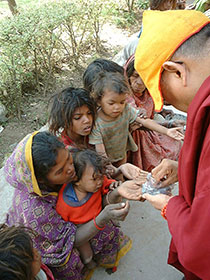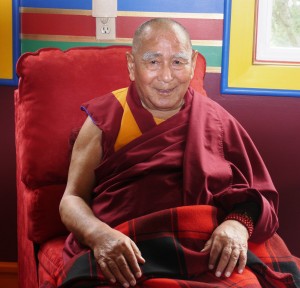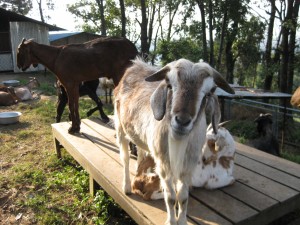- Home
- FPMT Homepage
Foundation for the Preservation of the Mahayana Tradition
The FPMT is an organization devoted to preserving and spreading Mahayana Buddhism worldwide by creating opportunities to listen, reflect, meditate, practice and actualize the unmistaken teachings of the Buddha and based on that experience spreading the Dharma to sentient beings. We provide integrated education through which people’s minds and hearts can be transformed into their highest potential for the benefit of others, inspired by an attitude of universal responsibility and service. We are committed to creating harmonious environments and helping all beings develop their full potential of infinite wisdom and compassion. Our organization is based on the Buddhist tradition of Lama Tsongkhapa of Tibet as taught to us by our founders Lama Thubten Yeshe and Lama Thubten Zopa Rinpoche.
- Willkommen
Die Stiftung zur Erhaltung der Mahayana Tradition (FPMT) ist eine Organisation, die sich weltweit für die Erhaltung und Verbreitung des Mahayana-Buddhismus einsetzt, indem sie Möglichkeiten schafft, den makellosen Lehren des Buddha zuzuhören, über sie zur reflektieren und zu meditieren und auf der Grundlage dieser Erfahrung das Dharma unter den Lebewesen zu verbreiten.
Wir bieten integrierte Schulungswege an, durch denen der Geist und das Herz der Menschen in ihr höchstes Potential verwandelt werden zum Wohl der anderen – inspiriert durch eine Haltung der universellen Verantwortung und dem Wunsch zu dienen. Wir haben uns verpflichtet, harmonische Umgebungen zu schaffen und allen Wesen zu helfen, ihr volles Potenzial unendlicher Weisheit und grenzenlosen Mitgefühls zu verwirklichen.
Unsere Organisation basiert auf der buddhistischen Tradition von Lama Tsongkhapa von Tibet, so wie sie uns von unseren Gründern Lama Thubten Yeshe und Lama Thubten Zopa Rinpoche gelehrt wird.
- Bienvenidos
La Fundación para la preservación de la tradición Mahayana (FPMT) es una organización que se dedica a preservar y difundir el budismo Mahayana en todo el mundo, creando oportunidades para escuchar, reflexionar, meditar, practicar y actualizar las enseñanzas inconfundibles de Buda y en base a esa experiencia difundir el Dharma a los seres.
Proporcionamos una educación integrada a través de la cual las mentes y los corazones de las personas se pueden transformar en su mayor potencial para el beneficio de los demás, inspirados por una actitud de responsabilidad y servicio universales. Estamos comprometidos a crear ambientes armoniosos y ayudar a todos los seres a desarrollar todo su potencial de infinita sabiduría y compasión.
Nuestra organización se basa en la tradición budista de Lama Tsongkhapa del Tíbet como nos lo enseñaron nuestros fundadores Lama Thubten Yeshe y Lama Zopa Rinpoche.
A continuación puede ver una lista de los centros y sus páginas web en su lengua preferida.
- Bienvenue
L’organisation de la FPMT a pour vocation la préservation et la diffusion du bouddhisme du mahayana dans le monde entier. Elle offre l’opportunité d’écouter, de réfléchir, de méditer, de pratiquer et de réaliser les enseignements excellents du Bouddha, pour ensuite transmettre le Dharma à tous les êtres. Nous proposons une formation intégrée grâce à laquelle le cœur et l’esprit de chacun peuvent accomplir leur potentiel le plus élevé pour le bien d’autrui, inspirés par le sens du service et une responsabilité universelle. Nous nous engageons à créer un environnement harmonieux et à aider tous les êtres à épanouir leur potentiel illimité de compassion et de sagesse. Notre organisation s’appuie sur la tradition guéloukpa de Lama Tsongkhapa du Tibet, telle qu’elle a été enseignée par nos fondateurs Lama Thoubtèn Yéshé et Lama Zopa Rinpoché.
Visitez le site de notre Editions Mahayana pour les traductions, conseils et nouvelles du Bureau international en français.
Voici une liste de centres et de leurs sites dans votre langue préférée
- Benvenuto
L’FPMT è un organizzazione il cui scopo è preservare e diffondere il Buddhismo Mahayana nel mondo, creando occasioni di ascolto, riflessione, meditazione e pratica dei perfetti insegnamenti del Buddha, al fine di attualizzare e diffondere il Dharma fra tutti gli esseri senzienti.
Offriamo un’educazione integrata, che può trasformare la mente e i cuori delle persone nel loro massimo potenziale, per il beneficio di tutti gli esseri, ispirati da un’attitudine di responsabilità universale e di servizio.
Il nostro obiettivo è quello di creare contesti armoniosi e aiutare tutti gli esseri a sviluppare in modo completo le proprie potenzialità di infinita saggezza e compassione.
La nostra organizzazione si basa sulla tradizione buddhista di Lama Tsongkhapa del Tibet, così come ci è stata insegnata dai nostri fondatori Lama Thubten Yeshe e Lama Zopa Rinpoche.
Di seguito potete trovare un elenco dei centri e dei loro siti nella lingua da voi prescelta.
- 欢迎 / 歡迎
简体中文
“护持大乘法脉基金会”( 英文简称:FPMT。全名:Foundation for the Preservation of the Mahayana Tradition) 是一个致力于护持和弘扬大乘佛法的国际佛教组织。我们提供听闻,思维,禅修,修行和实证佛陀无误教法的机会,以便让一切众生都能够享受佛法的指引和滋润。
我们全力创造和谐融洽的环境, 为人们提供解行并重的完整佛法教育,以便启发内在的环宇悲心及责任心,并开发内心所蕴藏的巨大潜能 — 无限的智慧与悲心 — 以便利益和服务一切有情。
FPMT的创办人是图腾耶喜喇嘛和喇嘛梭巴仁波切。我们所修习的是由两位上师所教导的,西藏喀巴大师的佛法传承。
繁體中文
護持大乘法脈基金會”( 英文簡稱:FPMT。全名:Found
ation for the Preservation of the Mahayana Tradition ) 是一個致力於護持和弘揚大乘佛法的國際佛教組織。我們提供聽聞, 思維,禪修,修行和實證佛陀無誤教法的機會,以便讓一切眾生都能 夠享受佛法的指引和滋潤。 我們全力創造和諧融洽的環境,
為人們提供解行並重的完整佛法教育,以便啟發內在的環宇悲心及責 任心,並開發內心所蘊藏的巨大潛能 — 無限的智慧與悲心 – – 以便利益和服務一切有情。 FPMT的創辦人是圖騰耶喜喇嘛和喇嘛梭巴仁波切。
我們所修習的是由兩位上師所教導的,西藏喀巴大師的佛法傳承。 察看道场信息:
- FPMT Homepage
- News/Media
-
- Study & Practice
-
-
- About FPMT Education Services
- Latest News
- Programs
- New to Buddhism?
- Buddhist Mind Science: Activating Your Potential
- Heart Advice for Death and Dying
- Discovering Buddhism
- Living in the Path
- Exploring Buddhism
- FPMT Basic Program
- FPMT Masters Program
- FPMT In-Depth Meditation Training
- Maitripa College
- Lotsawa Rinchen Zangpo Translator Program
- Universal Education for Compassion & Wisdom
- Online Learning Center
-
- Prayers & Practice Materials
- Overview of Prayers & Practices
- Full Catalogue of Prayers & Practice Materials
- Explore Popular Topics
- Benefiting Animals
- Chenrezig Resources
- Death & Dying Resources
- Lama Chopa (Guru Puja)
- Lama Zopa Rinpoche: Compendium of Precious Instructions
- Lama Zopa Rinpoche: Life Practice Advice
- Lama Zopa Rinpoche Practice Series
- Lamrim Resources
- Mantras
- Prayer Book Updates
- Purification Practices
- Sutras
- Thought Transformation (Lojong)
- Audio Materials
- Dharma Dates - Tibetan Calendar
- Translation Services
- Publishing Services
- Ways to Offer Support
- Prayers & Practice Materials
-
- Teachings and Advice
- Find Teachings and Advice
- Lama Zopa Rinpoche Advice Page
- Lama Zopa Rinpoche: Compendium of Precious Instructions
- Lama Zopa Rinpoche Video Teachings
- ༧སྐྱབས་རྗེ་བཟོད་པ་རིན་པོ་ཆེ་མཆོག་ནས་སྩལ་བའི་བཀའ་སློབ་བརྙན་འཕྲིན།
- Podcasts
- Lama Yeshe Wisdom Archive
- Buddhism FAQ
- Dharma for Young People
- Resources on Holy Objects
- Teachings and Advice
-
-
*If a menu item has a submenu clicking once will expand the menu clicking twice will open the page.
-
-
- Centers
-
- Teachers
-
- Projects
-
-
-
-
*If a menu item has a submenu clicking once will expand the menu clicking twice will open the page.
-
-
- FPMT
-
-
-
-
-
If you help others with sincere motivation and sincere concern, that will bring you more fortune, more friends, more smiles, and more success. If you forget about others’ rights and neglect others’ welfare, ultimately you will be very lonely.
His Holiness the Dalai Lama
-
-
-
- Shop
-
-
-
The Foundation Store is FPMT’s online shop and features a vast selection of Buddhist study and practice materials written or recommended by our lineage gurus. These items include homestudy programs, prayers and practices in PDF or eBook format, materials for children, and other resources to support practitioners.
Items displayed in the shop are made available for Dharma practice and educational purposes, and never for the purpose of profiting from their sale. Please read FPMT Foundation Store Policy Regarding Dharma Items for more information.
-
-
Mandala
21
The “Bollywood” Nun: An Indian Actress Takes Ordination Vows
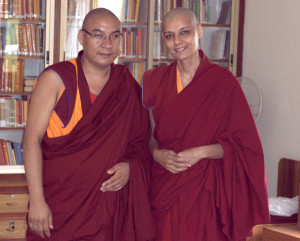
The newly ordained Ven. Gyalten Samten (right) with Geshe Sherab, Sera Je Monastery, November 2012. Photo by Bill Kane.
“History was made in South India at Sera Je Monastery when a 38-year-old Indian woman named Barkha Madan, who works as a model and Bollywood actress, became one of the first non-Himalayan Indian Tibetan Buddhist nuns in FPMT.
“… Now Ven. Gyalten Samten, she remains as beautiful as she is strong, kind, unpretentious and gentle, and she has great faith in Lama Zopa Rinpoche. She felt like she was taken by the hand and guided ‘to this end’ and feels that her being a nun will come out well for all sentient beings. ‘There is no turning back,’ she said. ‘On November 4, 2012, at 11:20 a.m., I was reborn.’”
From Mandala January-March 2013
17
An Irresistible Pull, Marcel Bertels’ Road to Kopan
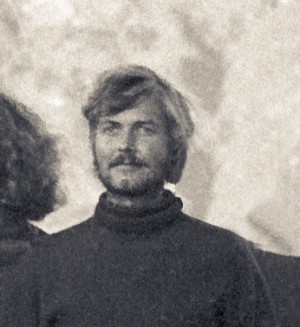
Marcel Bertels, at the Third Kopan Meditation Course, December, 1972. Photo courtesy of Lama Yeshe Wisdom Archive.
“As a child, I had an enormous attraction to and curiosity about Christianity,” shares long-time student Marcel Bertels, “but as there was nothing and no one to nurture this curiosity, even in the Roman Catholic system of which I was part, it was gone by the time I was eight or nine years old. After that, I basically had no more space for anything to do with religion.”
However, Marcel later did find space for Buddhism.
“Lama Zopa Rinpoche was a huge shock to my system. I had never seen or met anyone who was so far beyond a normal human being. Rinpoche’s demeanor was always very stern and serious in those days, completely single-minded, like there was simply no time to joke, quite different from how we experience Rinpoche now…”
From Mandala January-March 2013
- Tagged: mandala, your community
- 0
16
Finding Inspiration in FPMT Centers: An Interview with Geshe Sherab
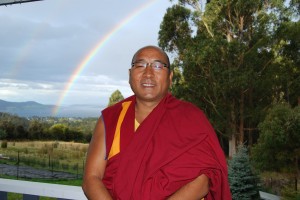
Geshe Sherab, Tasmania, Australia, August 2012. Phots by Kunchok Gyaltsen.
Geshe Thubten Sherab was born in 1967 in the Manang district of Nepal. He entered Kopan Monastery at age nine. He completed his Geshe degree at Sera Je Monastic University in South India, followed by a year at Gyumed Tantric College. Over the last decade, Geshe Sherab has taught all over the world as well as serving several years as Kopan’s Headmaster.
In 2012, Geshe Sherab spent three months touring the FPMT Australian centers, organized by FPMT in Australia. Mandala spoke with Geshe Sherab in October 2012 while he was at Kadam Sharawa Centre, located on the Central Coast of New South Wales, Australia.
Mandala: Are there advantages that Westerners have in terms of studying Dharma?
Geshe Sherab: Yes, absolutely. One of the advantages they have is that most have a good basic education, so when you explain the Dharma, I think it much easier for them to understand and to really get the essence of the Dharma. They are more interested in meditation and the essence of the Dharma than the ritual aspects. I believe that is good, it’s an advantage I think. When someone gets too into the ritual aspects, sometimes it is possible that he can lose the essence of the Dharma.
Westerners also come with a bit of a skeptical mind and I think that helps them too. When you come with that kind of skepticism and doubt, you take more caution, you reflect more, you contemplate more, and therefore you can develop greater understanding and knowledge.”
Read more …
From Mandala January-March 2013
- Tagged: mandala, your community
- 0
15
The Movement for Peace with Justice and Dignity, Addressing Drug Trafficking in Mexico
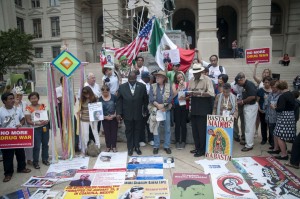
Caravan for Peace participants at Martin Luther King, Jr., Memorial, Atlanta, Georgia, U.S., August 2012. Photo: www.caravan4peace.org.
Within the FPMT mandala, there are many practitioners witnessing first-hand the violence, suffering and chaos that result from war, poverty, crime, corruption and other destructive social forces. In Mexico, the trafficking of illegal drugs has wrecked havoc on Mexican society. Karla Ambrosio, FPMT’s national coordinator for Mexico, shares how the teachings of Buddha are offering peace, insight and direction to those impacted by this violence and how a movement has developed that calls for compassion and love instead of retaliation and hate.
“Rafa is the brother of Juan Carlos and their lovely mother is Doña Mary, who is looking for her four lost sons. Two years ago, Jesús and Raúl made a journey from Michoacán to Guerrero on the Pacific Coast of Mexico, where they were kidnapped. A year later, Gustavo and Luis disappeared in Veracruz on the Atlantic Coast. The four brothers used to travel to maintain the family business. They are four of the 10,000 desaparecidos (missing people) and the 70,000 murdered when the war against drug trafficking began in Mexico in 2006.
“Doña Mary and her sons Rafa and Juan Carlos are members of the Movement for Peace with Justice and Dignity, a citizens’ movement that was born in 2011 when a Mexican poet named Javier Sicilia raised up his voice after his son was murdered and said fearlessly: ‘No more blood! We are sick and tired!’”
From Mandala January-March 2013
- Tagged: dharma in the modern world, mandala
- 0
14
The Mummification of His Holiness the 9th Bogd Jetsün Dampa Rinpoche

Mummification box of 9th Khalkha Jetsün Dampa Rinpoche, July 2012
Mongolia, while a traditionally Buddhist country, faced decades of religious oppression in the 20th century. The importance of Mongolia’s spiritual leaders during that period, however, did not decrease. Özer Rinpoche explains the significance of His Holiness the 9th Bogd Jetsün Dampa Rinpoche and the mummification of his holy body.
“His Holiness the Dalai Lama made the decision that the 9th Khalkha Jetsün Dampa Rinpoche should be mummified, a process not decided on or performed by just anyone. Mummification is not used for all lamas, only for the very highest of the high Lamas. Rinpoche’s mummification will be finished around March or April 2013 and his holy body will be placed in the former library of Ganden Monastery, which will be open for the public to receive blessings.”
Read more …
From Mandala January-March 2013
- Tagged: dharma in the modern world, mandala
- 0
11
A New Generation of Ladakhi Nuns
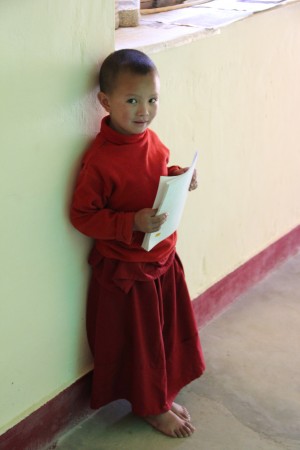
A young nun from the newly established Gephel Shadrubling Nunnery, 2012. Photo by Mary Wellhoner.
Dr. Mary Wellhoner, a student of Lama Yeshe and Lama Zopa Rinpoche, writes about the growing number of opportunities for Ladakhi nuns to access education and health care.
“Supported by the progressive policies of His Holiness the Dalai Lama and Lama Zopa Rinpoche, advanced Buddhist education for girls and women in Asia is taking a foothold in Ladakh. A somewhat revolutionary concept for traditional Tibetan culture and developing Asian countries, His Holiness and Lama Zopa Rinpoche have promised equal education for girls and women. As a result, a cohort of bright, energetic young female geshes is on the horizon at Khachoe Ghakyil Nunnery, FPMT’s largest nunnery in Kopan near Kathmandu, and at nunneries in Dharamsala under the guidance of the Tibetan Nuns Project.”
From Mandala January-March 2013
- Tagged: mandala, taking care of others
- 0
10
Paul Donnelly on the Creation of “Like a Waking Dream” [Audio Interview]
Wisdom Publications has just published Geshe Lhundub Sopa’s autobiography, Like a Waking Dream. In it, Geshe-la shares detailed memories of his youth and early days in the Tibetan monastic system and offers a first-hand perspective on exile and establishing Tibetan Buddhism in the West.
Paul Donnelly served as the editor of Like a Waking Dream. In 1989, Donnelly entered the Ph.D. program in Buddhist Studies at U.W. and became a student of Geshe-la. He graduated in 1997 and now is an associate professor of religious studies at Northern Arizona University.
Mandala managing editor Laura Miller talked to Donnelly from his home in Flagstaff, Arizona, about working on the book with Geshe-la. The conversation took place over Skype in October 2012. They began the discussion talking about how the book came to be.
Listen to the audio interview on fpmt.org/mandala/.
From Mandala January-March 2013
- Tagged: audio, dharma in the modern world, geshe lhundub sopa rinpoche, interview, mandala, your community
- 0
9
His Holiness at Kurukulla Center Photo Gallery

An enthusiastic crowd of nearly 2,000 people of all ages – including Kurukulla Center members, Boston-area Tibetans and Kurukulla Center neighbors – listened to His Holiness speak on universal human values and inter-religious harmony. For part of his talk, His Holiness spoke directly to the gathered Tibetan community in Tibetan. He expressed his admiration for how they have preserved their language and culture in exile and said that this, along with the strong spirit of Tibetans in Tibet, serves as grounds for hope for the future.
You can read the complete story of His Holiness’ visit in the print edition of Mandala January-March 2013.
Kurukulla Center has kindly provided Mandala with photos of the event, which we are happy to share here.
From Mandala January-March 2013
8
Geshe Lama Konchog, “An Extraordinary Modern-day Milarepa”
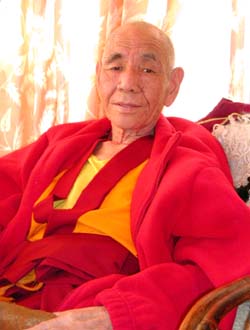
Geshe Lama Konchog. Photo by Nick Dawson.
Geshe Lama Konchog came to Kopan Monastery in 1984, where he spent nearly 18 years devoting himself to teaching the monks and nuns there. Before arriving at Kopan, Geshe Lama Konchog had spent twenty-five years meditating in caves in the Tsum region of Nepal. Geshe Lama Konchog was born in Tibet in 1927 and educated as Sera Monastery. He was known then for his profound commitment to Dharma practice. But it was only after his death in 2001 that his extraordinary qualities were revealed to a wider circle of Dharma practitioners and students. His disciple Geshe Tenzin Zopa detailed the accomplishments of this modern-day Milarepa and shared them with Ven. Robina Courtin for this story published in Mandala March-April 2002.
- Tagged: dharma in the modern world, geshe lama konchog, mandala, ven. robina courtin, your community
- 0
7
Ancient Philosophy in Everyday Life at the Himalayan Buddhist Meditation Centre, Nepal
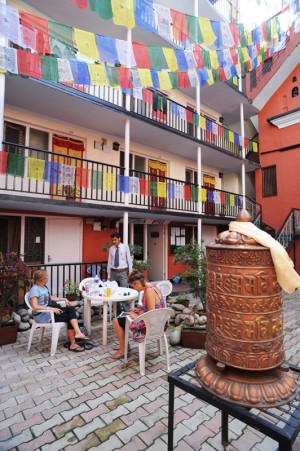
Himalayan Buddhist Meditation Centre, 2012
In 1982, the Himalayan Buddhist Meditation Centre (HBMC) was founded in Kathmandu as the Himalayan Yogic Institute (HYI) by Pam and Karuna Cayton, long-time students of Lama Yeshe and Lama Zopa Rinpoche. Thirty years later, their daughter Arya became the spiritual program coordinator there, bringing her experience and fresh perspective to the city center.
“It wasn’t my plan to work at the center my parents were involved in starting 30 years ago. I came to Nepal in 2011 with an idea for starting a social/creative business venture and with an undeniable interest in connecting more with the country where I was born and where spiritual practice is encouraged and accessible.
… After finishing college and doing the November course for the first time in 2009, I was amazed by how many people my age were there at Kopan. Up until that point, if I went to teachings at a center, I was usually the youngest person in the room and because of this I never really had Dharma friends my age. As my personal connection with Buddhism developed, the need for support from peers became more important. At the 2009 November course, I found it really refreshing and inspiring to meet so many young people from all over the world who had a genuine interest in the Dharma. Since then, I have noticed that many people my age are interested in Buddhism, but they just haven’t met with the right situation to learn more. Now as the current SPC at Himalayan Buddhism Meditation Centre, my wish is to help create a really welcoming and comfortable community space for people of all ages and backgrounds to explore Buddhism.”
From Mandala January-March 2013
- Tagged: dharma in the modern world, mandala, your community
- 0
3
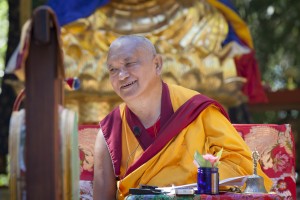
Lama Zopa Rinpoche, Ksitigarbha Day at Land of Medicine Buddha, Soquel, California, U.S., September 15, 2012. Photo by Dionne Wilson.
Lama Zopa Rinpoche shares techniques for transforming life’s difficulties into spiritual strength in “Seeing Problems as Positive,” an excerpt from Lama Yeshe Wisdom Archive’s How to Practice Dharma: Teachings on the Eight Worldly Dharmas.
“For worldly people the confusion caused by suffering only brings more suffering and confusion, but as Dharma practitioners we have the opportunity of making suffering extremely beneficial by using it to cut confusion rather than to create it. In order to achieve enlightenment we have to experience both physical and mental difficulties, but bearing such difficulties is incredibly worthwhile because by doing so we reach a state where all suffering ceases forever. As we progress along the path to enlightenment, problems become fewer and fewer and therefore whatever we experience at this time only helps to bring about the end of the suffering that has no beginning.”
From Mandala January-March 2013
- Tagged: mandala, teachings and advice
- 0
19
A Word from Kalarupa, the goat
Kalarupa, the goat, is a resident of the Animal Liberation Sanctuary at Kopan Monastery. For the latest online edition of Mandala, Kalarupa shares news of the activities at the sanctuary, where exciting developments are happening.
“I hear the people sometimes talking about the lower realms – ‘We have to get them out of the lower reams!’ – and they look at us,” Kalarupa writes. “I’m the tallest goat here, and I can tell you I wouldn’t want to be a short goat. That’s the lower realms, in my opinion.”
Read more from Kalarupa as part of the online edition of Mandala January-March 2013.
- Home
- News/Media
- Study & Practice
- About FPMT Education Services
- Latest News
- Programs
- New to Buddhism?
- Buddhist Mind Science: Activating Your Potential
- Heart Advice for Death and Dying
- Discovering Buddhism
- Living in the Path
- Exploring Buddhism
- FPMT Basic Program
- FPMT Masters Program
- FPMT In-Depth Meditation Training
- Maitripa College
- Lotsawa Rinchen Zangpo Translator Program
- Universal Education for Compassion & Wisdom
- Online Learning Center
- Prayers & Practice Materials
- Overview of Prayers & Practices
- Full Catalogue of Prayers & Practice Materials
- Explore Popular Topics
- Benefiting Animals
- Chenrezig Resources
- Death & Dying Resources
- Lama Chopa (Guru Puja)
- Lama Zopa Rinpoche: Compendium of Precious Instructions
- Lama Zopa Rinpoche: Life Practice Advice
- Lama Zopa Rinpoche Practice Series
- Lamrim Resources
- Mantras
- Prayer Book Updates
- Purification Practices
- Sutras
- Thought Transformation (Lojong)
- Audio Materials
- Dharma Dates – Tibetan Calendar
- Translation Services
- Publishing Services
- Teachings and Advice
- Find Teachings and Advice
- Lama Zopa Rinpoche Advice Page
- Lama Zopa Rinpoche: Compendium of Precious Instructions
- Lama Zopa Rinpoche Video Teachings
- ༧སྐྱབས་རྗེ་བཟོད་པ་རིན་པོ་ཆེ་མཆོག་ནས་སྩལ་བའི་བཀའ་སློབ་བརྙན་འཕྲིན།
- Podcasts
- Lama Yeshe Wisdom Archive
- Buddhism FAQ
- Dharma for Young People
- Resources on Holy Objects
- Ways to Offer Support
- Centers
- Affiliates Area
- Teachers
- Projects
- Charitable Projects
- Make a Donation
- Applying for Grants
- News about Projects
- Other Projects within FPMT
- Support International Office
- Projects Photo Galleries
- Give Where Most Needed
- FPMT
- Shop
Subscribe to FPMT News
Translate*
*powered by Google TranslateTranslation of pages on fpmt.org is performed by Google Translate, a third party service which FPMT has no control over. The service provides automated computer translations that are only an approximation of the websites' original content. The translations should not be considered exact and only used as a rough guide.When others insult, rebuke and speak unpleasant words to us, although an intolerable pain arises like a thorn at the heart, if we comprehend the teachings then we can recognize the essenceless nature of these words which resemble an echo. So just as when an inanimate object is scolded, we will experience not the slightest mental turmoil.







